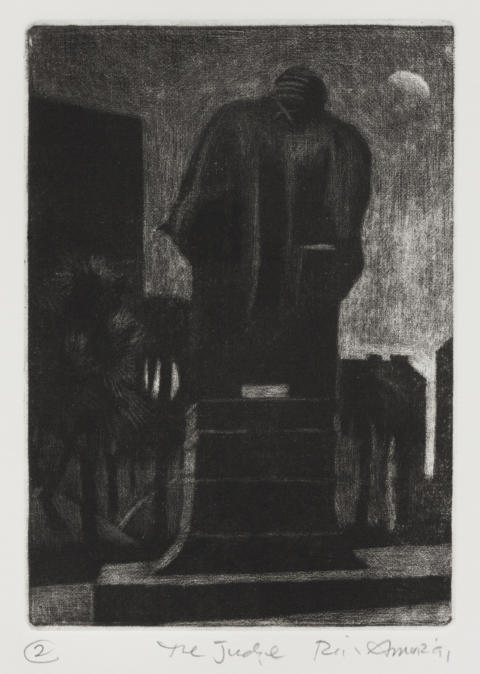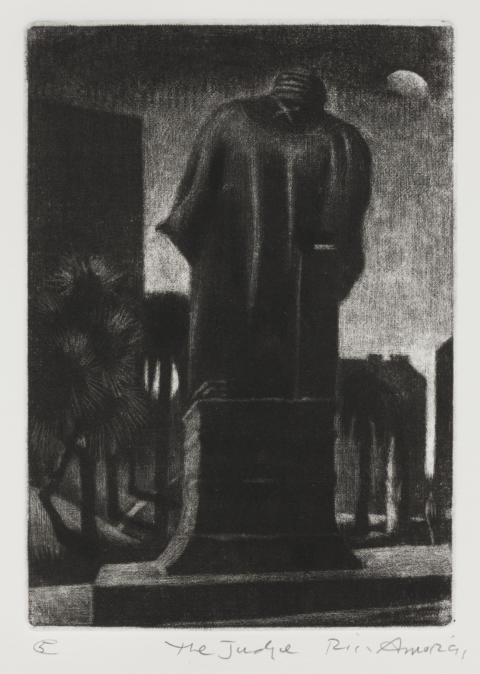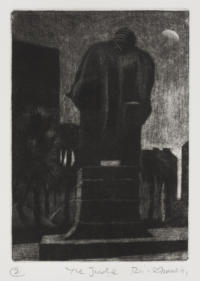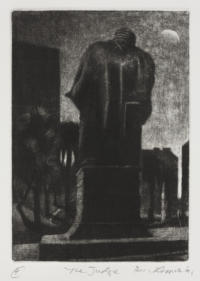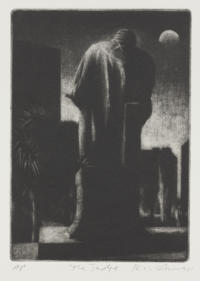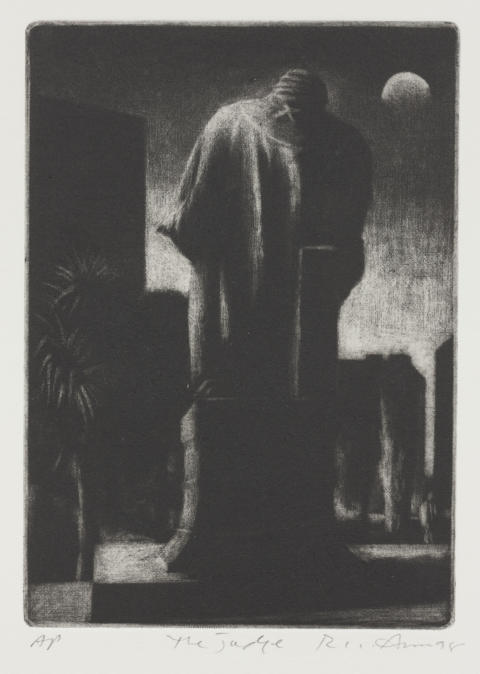
The sky has been lightened and the pedestal divided by three narrow horizontal bands. Above the pedestal, and just below the robes, is a narrow horizontal rectangle of light.
Stronger highlights have been burnished into the robes, the sky has been lightened, and numerous areas of the composition have been burnished in order to clarify the subject. The figure of a man now appears in the shadows at the lower right of the image, just below the gap between the buildings.
The upper part of the sky has been reworked with the mezzotint rocker and is now darker. The robe has been defined more clearly and its light areas have been tonally evened out.
The wig, the left shoulder, and the robe at left, have been made considerably lighter. The figure now appears distinctly to be leaning forward and to the right. The trunks of most of the trees at the lower left have been removed, though the spiky foliage remains. The three intervals of light between the trees in the middle left distance have been removed.
- Catalogue Number
- E.047
- Title and Date
- The judge
1991; reworked 1998
- Description of Featured Image
- A rear view of a large statue of a figure in legal robes and wig; the statue and its pedestal are illuminated from the left. Silhouetted in the distance are city buildings and in the upper right corner is the moon, whose lower half is not visible. To the left of the statue is a pandanus-like tree, and there are other trees beyond it; in the right distance is a palm tree.
- Where Made
- Dunmoochin, Cottles Bridge
- Medium Category and Technique
- Intaglio Print: Mezzotint on copper
- Support
- Wove paper. Identified papers: Fabriano paper with watermark: ‘CMF’ with star above, within a circle/oval; BFK Rives paper; Hahnemühle paper with watermark: ‘HAHNEMÜHLE’.
- Dimensions
-
Image size: 204 x 144 mm
Matrix size: 205 x 147 mm - Artist’s Record Number
- RAE.43 (1991), RAE.126 (1998), RAE.149 (2002)
- Printer(s) and Workshop(s)
- States I through V, and first edition, printed by Rick Amor in his Dunmoochin studio, Cottles Bridge. State VI, and second edition, printed by Amor in his Alphington studio. Third edition printed by Martin King at the Australian Print Workshop, Fitzroy (Melbourne).
- Summary Edition Information
- Six states. Three editions. First edition: edition of ten numbered impressions, 1991. Second edition: nominal edition of ten, but only four impressions printed and numbered, 1998. Third edition: edition of ten numbered impressions, 2002.
- Exhibitions
- Niagara Galleries & NETS Victoria 1993–94: Niagara Galleries & NETS Victoria, Melbourne, Rick Amor & the Graphic Arts, Victorian and Tasmanian tour, 1993–94, no. 40 (1991 edition).
- Niagara Galleries at IWOP 1997: Niagara Galleries at the International Works on Paper Fair, Mitchell Galleries, State Library of New South Wales, Sydney, 17–20 July 1997, no. 5 (1991 edition).
- Niagara Galleries 1999: Niagara Galleries, Richmond (Melbourne), Rick Amor Sculpture, 2–27 March 1999, no. 5 (1998 edition).
- Heide MoMA 2008: Heide Museum of Modern Art, Bulleen (Melbourne), Rick Amor: A Single Mind, 22 March – 13 July 2008, no. 8 (Prints) (2002 edition).
- British Museum 2011: British Museum, London, Out of Australia: Prints and Drawings from Sidney Nolan to Rover Thomas, 26 May – 11 September 2011, no. 85 (2002 edition).
- Literature
- Gary Catalano, The Solitary Watcher: Rick Amor and His Art, Melbourne University Press, Carlton South, Victoria, 2001, pp.163–4.
- Stephen Coppel, Out of Australia: Prints and Drawings from Sidney Nolan to Rover Thomas (exh. cat.), British Museum Press, London, 2011, p. 137 (illus.).
- Collections
- State Library of Victoria, Melbourne: five state impressions, numbered 1 through 5, all dated 1991; bon à tirer impression, dated 1991; ed. 9/10, dated 1991; ed. 3/10, dated 1998; ed. 4/10, dated 2002.
- Art Gallery of South Australia, Adelaide: ed. 4/10, dated 1991 (20155G140).
- British Museum, London: ed. 3/10, dated 2002 (2006,0730.34).
- National Gallery of Australia, Canberra: ed. 2/10, dated 1991 (2007.712); APW workshop proof 2/2, on cream paper, dated 2002 (2002.431.1217).
- National Gallery of Victoria, Melbourne: ed. 7/10, dated 2002 (2012.412).
- Comment
The statue in this work is based on the Edmund FitzGibbon Memorial, by James White, a bronze funded by public subscription in Melbourne in the early twentieth century. Edmund FitzGibbon (1825–1905) was a civic administrator in nineteenth-century Melbourne; born in Ireland, he arrived in Australia in 1852, became town clerk of Melbourne in 1856, and was admitted to the Bar in 1860. His memorial statue, unveiled in 1908, was initially situated at Princes Bridge but has been moved several times since. When Amor first depicted it, in 1988, it was located in Spring Street, near the Princess Theatre. It now stands on the corner of St Kilda Road and Linlithgow Avenue, Melbourne, diagonally opposite the National Gallery of Victoria.
Amor’s earliest representations of the FitzGibbon Memorial are two watercolour drawings in a small sketchbook from 1988: one of these shows the statue on its tall pedestal, rising high above its setting in public gardens; the other shows just the figure in its voluminous robes. In 1989, Amor made the sculpture the subject of a painting, which is compositionally similar to E.047 but in reverse orientation (Geelong Gallery). In 1990, the statue appeared in a woodcut titled The judge, with the final manifestation of the image occurring in the present mezzotint. In all of these depictions, the figure of the lawyer, seen from behind and from a low viewpoint, takes on a looming anonymity, standing for something beyond itself. Writing of the 1989 painting, Gary Catalano observed that it ‘cows us through its forbidding bulk’ and inspires fear (Catalano 2001). E.047, although smaller in scale, is comparable in character and in the atmosphere it conveys.
Amor brought to the mezzotint the inspiration he found in Franz Kafka’s novel The Trial (Der Prozess; first published 1925) and in Orson Welles’s 1962 film of the book. The artist saw the Welles film before reading the book, and remembers the scene in which K met the painter Titorelli and saw his painting propped up on an easel (a scene drawn from the book). This painting depicted a figure who looked like an enlarged dwarf, and it is just this sense of dislocated scale that characterizes E.047. Stephen Coppel sees in the print’s ‘domineering monumentality’ and anonymity the ‘implication … that justice is blind. The shadowy highlights created by burnishing the heavily worked mezzotint plate lend the moonlit scene its curious amalgam of Kafkesque nightmare and De Chirico’s deserted public spaces’ (Coppel 2011).
- Keywords
- Edmund FitzGibbon, Franz Kafka, James White, Judge, Law, Melbourne, Statue
- URL
- https://catalogue.rickamor.com.au/works/intaglio/the-judge/
Record last updated 15/02/2021
